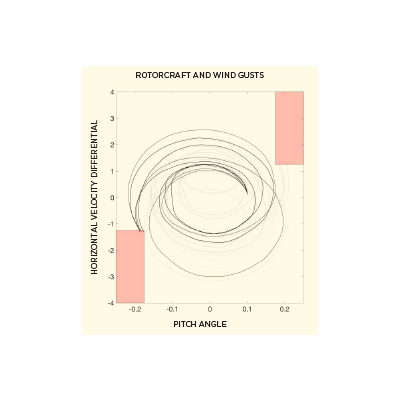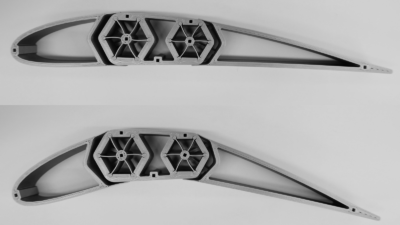Materials that remember show promise for aircraft and space applications
By DARREN J. HARTL|December 2019
The work of the Adaptive Structures Technical Committee enables aircraft and spacecraft to adapt to changing environmental conditions and mission objectives.
New applications of shape memory materials were demonstrated worldwide this year, while new morphing structural concepts were tested in new ways.
Boeing and NASA’s Glenn Research Center in Ohio tested shape memory alloys, or SMAs, that could be incorporated into the composite materials that form the components of deployable structures on commercial airplanes. These SMA compositions would respond autonomously to ambient temperature changes. The new NASA-Boeing SMAs were incorporated into the hinge of a deployable vortex generator that was flight-tested on a Boeing 777-200 in November as part of the company’s ecoDemonstrator program. The vortex generator retracts at cruise to reduce drag.
At the same time, Texas A&M University researchers worked with University of British Columbia to develop SMA artificial muscle actuators mimicking the functionality of characterized bird muscles. Results were first presented publicly in May, showing that SMA components can act as actuators, brakes and structural components under cyclic stimuli, emulating avian muscle functions.
In July, the Harbin Institute of Technology in China revealed the existence of an experimental satellite that tested a prototype shape memory polymer composite for self-deploying solar arrays, or SMPCs. In a paper in the journal Smart Materials and Structures, the designers of the experiment, called Mission SMS-I, described the mission as the first SMPC demonstration in geostationary orbit. The authors said they have proved that their carbon-reinforced SMPC can deploy solar arrays by direct harvesting of solar energy without drawing system electrical power. To increase the stiffness of the solar array, new SMPC-based structures were studied this year toward the goal of a second round of flight testing, according to the authors.
A number of new wind tunnel demonstrations of aeronautical adaptive structures applications were also performed this year. To quantify for the first time experimentally the acoustic benefit of an SMA slat cove filler in transport aircraft, researchers from Texas A&M University and NASA’s Langley Research Center in Virginia deployed a new aeroacoustic wind tunnel at Texas A&M in February and recorded a 2 decibel noise reduction at 20 meters/second on a 6.25% scale wing model. An international team from Boeing, Deharde, the European Transonic Windtunnel and Langley demonstrated a new wind tunnel testing paradigm allowing airplane models to be actuated in a cryogenic wind tunnel, even given small model feature sizes. The test article consisted of a 4.5% scale Boeing-787 half-model with control surfaces powered by fully integrated SMA rotary actuators. In August, the model was tested at cryogenically simulated flight Reynolds number conditions. Another collaborative project initiated this year by the University of Maryland, University of Bristol and Intelligent Automation Inc. with NASA support demonstrated the feasibility of a camber morphing wing prototype. The prototype consisted of multimaterial 3D-printed morphing skins supported by a 3D-printed bioinspired flexure. The prototype’s 60-centimeter camber morphing section was actuated in a 24 m/s free jet wind tunnel with minimal flutter. Upscaling and flight tests are planned for future phases.
Regarding noncommercial applications of adaptive structures, in September, the Aerospace Systems Directorate of the Air Force Research Laboratory first demonstrated a multiphysical “dry tunnel” that creates a simulated aerothermal test environment for morphing missiles. The approach gives researchers uninterrupted access to the structurally adaptive test article during simulated flight testing for full field strain and temperature tracking and allows testing of various missile articulation mechanisms across a range of speed and altitude conditions not achievable in traditional wind tunnels.
University of Central Florida researchers funded by the U.S. Navy’s Office of Naval Research this year explored transient fluid-structure interactions during sea-based air vehicle morphing to find optimal configurations for modular high-stiffness structures. The researchers measured the unsteady forces on a twisting and bending compliant wing via water towing tank experiments, validating the concept and enabling new modeling approaches.


































